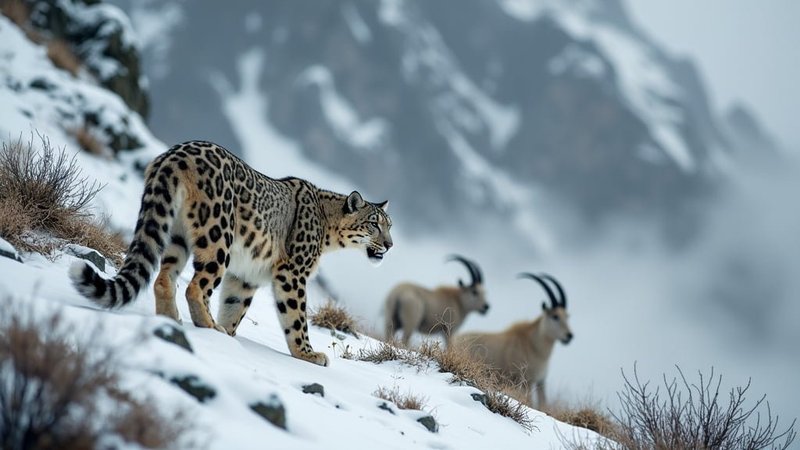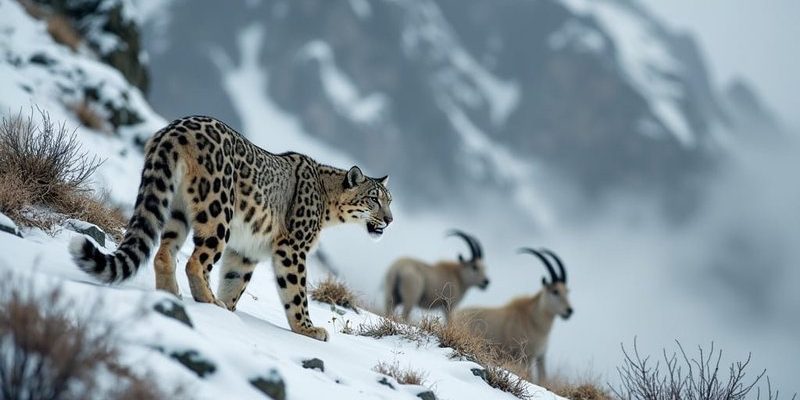
Let’s dive into the intricate world of snow leopards, exploring their dietary preferences, hunting techniques, and the challenges they face in their remote habitats. You might be surprised at how these magnificent predators balance survival and adaptation in some of the harshest environments on Earth.
Understanding the Snow Leopard’s Diet
Snow leopards are primarily carnivorous, which means their diet mainly consists of meat. They are expert hunters, targeting animals that thrive in their mountainous territory. These felines are known to feast on various prey, which can include:
- Mountain goats
- Ibex
- Wild sheep
- Marmots
- Small rodents
Most of their preferred prey are not just any animals; they’re typically quite agile and live in steep, rocky terrains. Snow leopards have adapted to hunt animals that are agile and adept at navigating such landscapes. This means they’re not just looking for a meal but are choosing their dinner guests with care, which shows a deep connection to their environment.
The Art of Hunting
Hunting is an art form for snow leopards, and they have developed distinctive strategies that set them apart from other big cats. Patience is critical; they often rely on a stealthy approach. Picture this: they quietly stalk their prey, sometimes zigzagging along rocky outcrops to avoid detection. Their thick fur and unique spotted coats help them blend into the rocky landscape, making their approach almost invisible.
Once they’re close enough, they rely on their powerful legs to make quick jumps. Snow leopards can leap up to six times their body length, making that critical moment of the hunt both thrilling and efficient. They might wait for the perfect moment when their target is distracted or lower their guard—then, in a flash, they pounce.
Unique Killing Techniques
Unlike many other big cats that tend to go for the throat or suffocate their prey, snow leopards often employ a different technique. They typically aim for the back of the neck, delivering a swift bite that can incapacitate their prey quickly. This method helps them take down larger animals effectively, which is vital for their survival in the wild.
Once their prey is down, snow leopards often drag their meals to a safer location to eat. This instinct is essential for avoiding scavengers or other predators in the area. It’s like putting a “Do Not Disturb” sign on their dinner—ensuring they can enjoy their hard-earned meal without competition.
Seasonal Diet Changes
As seasons change in their mountainous habitats, so do the snow leopard’s dining options. In winter, their preferred prey may migrate to lower elevations, making hunting more challenging. During these times, snow leopards may adapt by hunting smaller animals like rodents or even scavenging the remains of larger animals killed by other predators.
This flexibility is a testament to their survival skills. When you’re facing the extreme conditions of high-altitude living, being a picky eater isn’t an option. The snow leopard’s ability to adapt their diet not only helps them survive but also shows their resilience in harsh environments.
Challenges in Their Hunting Environment
Living in rugged, mountainous terrains comes with its own set of challenges. Snow leopards have to navigate steep cliffs, rocky slopes, and unpredictable weather. Here’s the thing—you might think that being a top predator gives snow leopards an edge, but they face threats like habitat loss and poaching, which impact their ability to hunt effectively.
Additionally, the prey they depend on can be threatened by human activities, leading to food shortages. It’s a tough balance, with the snow leopard needing to find enough to eat while the environment around them is changing rapidly. These challenges show just how delicate the ecosystem is in the regions where snow leopards roam.
The Role of Snow Leopards in Their Ecosystem
Snow leopards play a crucial role in their ecosystem, acting as apex predators. By keeping the populations of their prey in check, they help maintain a balance in the ecosystem. This balance supports a diverse array of plant and animal life, which is essential for a healthy environment. When you remove a top predator like the snow leopard, it can lead to overpopulation of certain species, which in turn affects vegetation and the overall health of the habitat.
Their presence in these rugged landscapes is essential—not just for the animals they hunt, but for the entire ecological community. It’s like a chain reaction; their hunting helps sustain the health of their habitat, which ultimately contributes to the survival of many other species.
Conservation Efforts for Snow Leopards
Given the numerous challenges snow leopards face, conservation efforts are crucial. Many organizations work hard to protect their habitats and promote coexistence with local communities. These efforts include creating protected areas and educating people about the importance of snow leopards in their ecosystems.
Community-based initiatives aim to reduce human-wildlife conflict by promoting sustainable livelihoods that do not threaten these magnificent creatures. For instance, engaging local herders in conservation can lead to more significant support for protecting snow leopards, ensuring they maintain their crucial role in the ecosystem.
In conclusion, the snow leopard’s diet and hunting strategies are a magnificent interplay of instinct, adaptation, and survival in challenging environments. They are more than just fierce hunters; they are integral players in the health of their ecosystems. By understanding and supporting conservation efforts, we can help ensure that these incredible animals continue to thrive in the wild. Isn’t it inspiring to think that every effort counts towards preserving such a majestic part of our planet?

